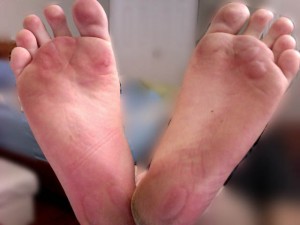 If you’ve lived long enough, you’ve learned to be skeptical. Maybe cynical. You may even have crafted a few homemade conspiracy theories that you’re reluctant to divulge because everyone knows what conspiracy theories mean. (They mean you’ve taken the first step on the meandering trail to someone’s-been-sneaking-into-my-apartment-and-moving-my-reading-glasses-and-car-keys.)
If you’ve lived long enough, you’ve learned to be skeptical. Maybe cynical. You may even have crafted a few homemade conspiracy theories that you’re reluctant to divulge because everyone knows what conspiracy theories mean. (They mean you’ve taken the first step on the meandering trail to someone’s-been-sneaking-into-my-apartment-and-moving-my-reading-glasses-and-car-keys.)
You might even think that Nike’s huge advertising budget could influence reporting on the subject of whether people need running shoes. As we noted earlier, there’s a recent school of thought that modern running shoes (those introduced since the 1970s) do more harm than good: they encourage a running style in which the heel strikes the ground first, which—thick cushions notwithstanding—sends shock waves up your leg and damages your knees and hips. Ideally, the argument goes, people should run like they ran across African savannahs tens of thousands of years ago. (Assuming you are among the 49 percent of Americans who say they believe in evolution, and not among the 39 percent who believe that “God created human beings pretty much in their present form at one time within the last 10,000 years.”)
So is this just a fad? Or is the media tip-toeing around the benefits of barefoot/minimalist-shoe running? Or is the research still inconclusive?
Probably the last. The New York Times has a recent piece that acknowledges that current “scientific research is just inadequate to answer” questions about the best way to run, or the best footwear for the masses. And, it’s safe to deduct, there’s even less guidance about what works best for older runners, with their particular needs.
The piece highlights several interesting and not particularly definitive studies, including one that looked at the best of the best: elite runners at the 10,000-meter Olympic trials. “Some landed heel first. Some landed on the midfoot. A few landed on the forefoot. Some twisted their feet inward as they struck the ground, while others kept their feet straight.”
Correlating injuries with running styles is made difficult by the fact that many people can’t accurately define how they run. One study found that runners—some wearing conventional shoes, some wearing minimalist shoes—didn’t have a very good idea of their running style. About a third of the “minimalists” thought they were running on the middle or front of their feet, and instead were hitting heel-first, without the cushioning needed to protect their joints.
Looking just at the efficiency, still other studies show that “striking midfoot or forefoot was no better and no worse than heel striking.”
So: lots of research, none of it giving a definitive answer about what works best. Because we’re aging, and seem to have less natural padding in our feet, we’re sticking with cushioned shoes…but taking some of the impact off the heels sounds like a smart idea.
Photo of friction blisters due to running barefoot, by Andry French, via Wikimedia Commons.









